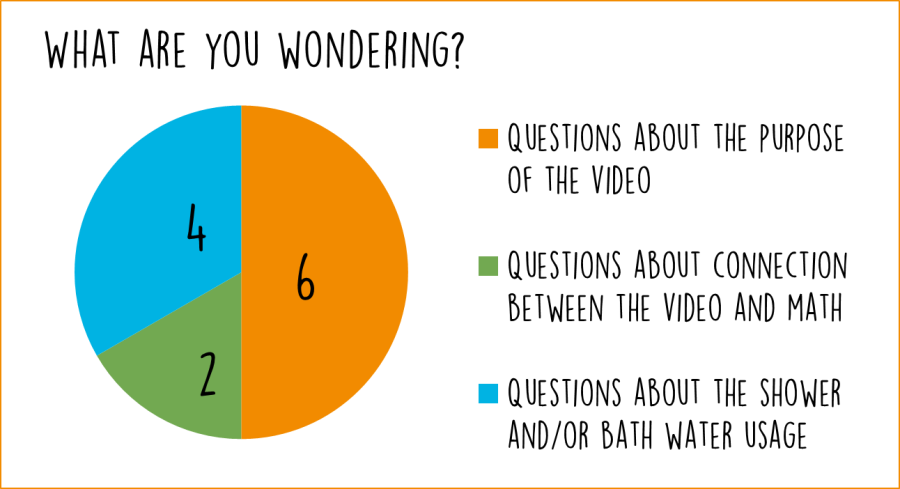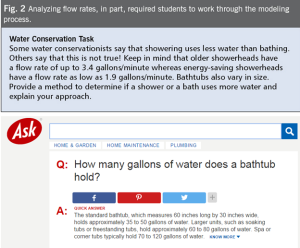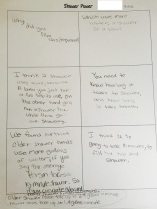What’s in this post:
- Why mathematical modeling is super important in tearing down “country club” mathematics
- An example lesson I taught that incorporating the modeling cycle
- All of the resources from that lesson.
Before Our Students Can Persevere, We Need to Trust Them
Make sense of problems and persevere in solving them. That’s the first Standard of Mathematical Practice in the Common Core, and for good reason. Perseverance is fundamental to mathematics – you need to give the content a chance if you are ever going to uncover its essential understandings. While it is easy to pin this off on students for not engaging (how dare you not persevere! I spent a lot of time last night coming up with this activity!), us math teachers actually have the greatest impact on our student’s math agency.

Many of our students suffer from a deep anxiety of mathematics, and this leads to otherwise competent students performing poorly simply because of their anxiety. This is compounded with students of color and women, where stereotype threat adds another barrier between capability and performance. And here’s the catch: “traditional” teaching techniques amplify math anxiety. Dan Meyer talks about “country club mathematics,” where students are implicitly and explicitly told that math means to “…calculate quickly and accurately with memorized formulas…and then raise your hand politely.” This is fine if you are a member of the country club, but alienating for those who are locked outside. When you imagine such disempowerment compounding across a dozen years and thousands of daily experiences with school mathematics, it’s suddenly not very surprising that many students (especially students of color and women) have no will to persevere with mathematics. Their attitude has absolutely nothing to do with competency. It has everything to do with our willful exclusivity.
So let’s break down the country club walls. Lucky for us, we have a bulldozer ready and waiting – our humble friend mathematical modeling. Here is how the modeling cycle is defined in Common Core (thanks to Dan Meyer and Felton, Anhalt, and Cortez for laying this out so nicely):
- Make sense of a situation
- Create a model to solve the problem
- Compute a solution with this model
- Interpret what those results mean in context
- Check the validity of your solution (and, if that fails, go back to step 1 or 2)
- Share your conclusions and reasoning
The “traditional” approach often jumps immediately to step 3 – we tell students “here, I put all of the information for you into this nice block of text. And here is the equation you should use. Just plug in that information correctly and spit out an answer. And don’t forget your units!” Stop! That’s not how the real world works!
The Modeling Cycle in Action
In order to try out the modeling cycle, especially how students first react to such instruction, I headed to Ruleville Middle School. In Ruleville I partnered with Scotty Jean-Baptiste and some of his incredible 8th grade students. The task that I implemented was based on the “Water Conservation” task detailed in this article from MTMS. I adapted the task into a “Developing the Question” structure which Dan Meyer demonstrated during his CHAMPS presentation last year (please, Mr. Meyer, come back to Mississippi!). Below I have detailed each part of this lesson and the student responses. I was impressed with the ability of Scotty’s students to go from hesitant, to curious, to exploratory with this unfamiliar structure which countered country club mathematics. You can see the raw data of their responses here.
- Make Sense of a situation.

To begin I introduced myself to students and let them know that I was going to show them part of a video I had recorded that week (I realized afterwards that Mr. Meyer already had a similar Three-Act Math task already designed – womp).I also handed out a super minimal worksheet with 6 “boxes” for us to organize our thoughts throughout the process. We watched the first few seconds of this video, which showed a split-screen of my bathtub filling up from the faucet (top) and from the showerhead (bottom). I then stopped the video and asked students “What are you wondering? What questions do you have?” They filled their responses into the first box of their worksheet. Given that students had not experienced the modeling cycle before (or at least this year), they were understandably caught off guard – this isn’t how math lessons work!
 I had students share their responses, wrote these on the board, and asked who else was wondering something similar. This gave me a bank of student-generated questions that we could come back to again at the conclusion of the lesson. It also served as a point of affirmation, where students saw that they weren’t alone in their thinking.
I had students share their responses, wrote these on the board, and asked who else was wondering something similar. This gave me a bank of student-generated questions that we could come back to again at the conclusion of the lesson. It also served as a point of affirmation, where students saw that they weren’t alone in their thinking.
 But we did have a specific question to address, and so in the second box I had students write our question of the day: Which uses more water, a shower or a bath? We immediately followed this up by coming up with an initial guess and justification. Where did the students stand on this? We had an even split (and nobody saying that it depends).
But we did have a specific question to address, and so in the second box I had students write our question of the day: Which uses more water, a shower or a bath? We immediately followed this up by coming up with an initial guess and justification. Where did the students stand on this? We had an even split (and nobody saying that it depends).
I let students share out some of their justifications, which showed a lot of nuance for the context. Many in the shower group justified their response with the fact that the shower only “trickles” water, while the bath group countered by saying that you run the bath once and then you’re done.
- Create a model to solve the problem
The fourth box is my favorite, and really determines the direction of the task. I asked students “well, what do you want to know?” This part of the cycle is vital because it students are elevated as fact-finders and creators of knowledge. Students, rather than teachers, get to determine what variables we should consider for our model. We teachers are often terrified to do this since we worry that students won’t provide the “right” variables or will draw complete blanks, but I challenge us to take a back-seat and try this out. Given students a chance to be knowledge-creators. Even though they had never engaged in a modeling activity before, the students in my lesson came up with some pretty spot-on answers about what we needed to know.
Now, with more time I would have students actually get on computers (or I could do this from the front board) to try and find answers to these questions. For the “time to take a shower or bath” they could even conduct a student poll and average their results. There are lots of directions to go here. In anticipating these variables, and knowing that I had a limited class time to conduct the task, I had already pulled some different sources, including actually revealing the full “word problem” version of the water conservation task.

- Compute a solution with this model
- Interpret what those results mean in context
We discussed this for a bit and then I let students have at it. I encouraged them to use the back of their papers and their whiteboards to sketch out their work, and then to use box 5 for their final conclusion and explanation.
It was a blast. One group settled on an average of a 15 minute shower while the other used 30 minutes as their average. Given that one of the students said she took 45 minute showers (she was a really big proponent of Team Shower), I encouraged them to see how a 45 minute shower average would change their results. Students suddenly started to realize that their results really depended on a lot of different things (our variables!). As groups began to stumble upon this realization, I began asking “how long would the shower have to be in order to use more water than a bath?” since that was ultimately what I wanted us to validate with our video from the beginning.
- Check the validity of your solution (and, if that fails, go back to step 1 or 2)
- Share your conclusions and reasoning
We had about 10-15 minutes of exploration before I pulled the groups together and had each one share. I loved that students had used different shower lengths for their model, since that allowed us to really have a discussion about how those variables impacted their results. In a perfect world this is where I would have wanted them to go back and refine their answers – their conclusions were from before they discussed with other groups. However, time was running out and so we moved on. I was happy that a majority of the class had changed their mind from their original views – 75 percent had referenced on their worksheet that different variables result in different results (although only four fully responded in writing to the original question comparing baths and the showers).
We went back to our original video and I asked students to make a prediction about how long the shower will take to fill up the bathtub. Again, in a perfect world we would have tackled this specific question collaboratively in box 6 instead of me quickly having them estimate, but time was short. Regardless, they seemed to enjoy watching the time-lapse, especially as we approached and then passed more and more predictions. The students I spoke with afterwards really appreciated how different it was from their typical perception of math lessons. “Other teachers just tell,” one student said, “but you had evidence.”
This was the first time (at least to my, Scotty, or the students’ knowledge) that they had engaged in a modeling lesson. Concerns of management, timing, and control often keep us teachers from ceding control of thinking to our students, but this is an absolute necessity if we ever expect them to persevere and overcome challenges. “Nobody rises to low expectations” as the old saying goes. Our students not only have the potential to meet and exceed high expectations, they have a right to do so. It is time to tear down the country club walls and give all of our students the opportunity to succeed.
All of the Resources
My PowerPoint (I’m telling you, it is bare-bones. We don’t need a fancy presentation when our focus is on student thinking and discussion)
An explanation of the Worksheet (ditto.)
Dan Meyer’s version of the shower versus bathtub comparison
MTMS article that includes the Water Conservation task and discusses the modeling cycle





Thanks for the write-up here, Ethan, both of our conference work and where you’ve taken the ideas. I like the modeling task and I like your interpretation of the “country club.” I’m not totally clear from your write-up how one leads to the other, though. How do you see this modeling task leading to greater access to that club?
Hi Dan. Thanks so much for taking the time to give this a read – I really appreciate your thoughts. I also think that your question is spot on – I dug into a lot of what the “country club” is here, and how my modeling activity went, but the bridge between the two isn’t as clearly laid out.
While I don’t think a one-off modeling lesson can do much to create greater access, the hope is that repeated emphasis on sense-making and validation of student thinking is key to improving agency from the least-served math students. By “democratizing” this process through the modeling cycle, we can maximize the amount of time for students to make personal meaning of the content and we can demonstrate that their voices are valued.
Ultimately I’d like the emphasis on “questioning” to establish an intellectual need for the content students are exploring, but at the very least I find that these techniques can address the affective needs of poorly-served students. This is definitely something that I want to dig into more in another post once I’ve explored it further.
Thanks again for your response and insight, Dan!